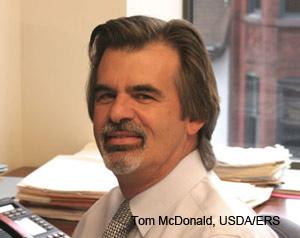Profiles
- Contact: Website Administrator
- 11/1/2005
Jim Blaylock

If, as Napoleon observed, an army marches on its stomach, then economists march on their data. A recent $3.5-million ERS research and data initiative exemplifies this point. These new data and analyses will help us fulfill ERS’s mandate to understand the relationships among eating, economics, health, consumer behavior, and the food system. Jim Blaylock, Associate Director of ERS’s Food Economics Division, is one of several ERSers who made this initiative a reality. As Jim notes, “These new data and surveys will provide real-time information on consumers’ purchasing responses to price changes, health concerns, new products, biotechnology, and food safety incidents.”
Jim’s leadership is a continuation of his long-time interest in answering the simple, skeptics might even say naïve, question, “Why do consumers eat what they do?” By the 1990s, it was apparent that eating was such a complex phenomenon that the old standbys of prices and income were not adequately explaining eating trends. Jim and his colleagues began to incorporate consumers’ nutrition knowledge and attitudes, among other explanatory factors, into models explaining food choices. Of course, the importance of understanding food consumption only grew along with the Nation’s waistline.
Jim’s research interests and mentoring efforts have shaped much of the work of the Division, especially in the area of food choices. Through direct collaborations and, more recently, through intellectual leadership, Jim has helped guide the Division’s food policy research program. Highlighting these endeavors were projects on consumer-driven agriculture (as featured in an earlier issue of Amber Waves), work exploring 100 years of eating in America as part of USDA’s Millennium celebration, and efforts highlighting the role of economics in the obesity debate.
As Associate Director, Jim uses his insights and lively writing style to make the Division’s analyses more accessible and visible to a wider audience. Jim challenges researchers to not just report on trends in food spending, marketing, and eating patterns but to “explain to our audience the forces behind the trends and what they mean for agricultural producers, food companies, and consumers.”
Ron Durst

The impact of Federal estate and gift taxes on farmers’ ability to transfer farm assets to younger generations has been a major concern for farmers and policymakers. In recent years, increasing farm size and rising land values have intensified this concern. As USDA’s expert on how tax policy affects farmers and agriculture, Ron Durst, a senior ERS economist, estimated the impact of Federal estate and gift tax changes enacted in 2001. Using USDA’s farm household survey data and the ERS farm typology, Ron determined that the tax policy changes would result in a large drop in both the number of farm estates required to file a return and that owe taxes. These results have been cited by senior USDA officials, congressional staff, and the farm press on a number of occasions.
Since joining ERS in 1980, Ron’s interests and responsibilities have covered all aspects of Federal taxation including income, estate and gift, and social security policies. Most recently, Ron, who holds degrees in agricultural economics and tax law, has been assessing the potential for farm savings accounts to help farmers manage the variability in their farm income and in evaluating the effects of Federal tax legislation for farmers. “Taxes can affect farm operations and farm families very differently than they can nonfarm businesses and other taxpayers. Understanding those differences is crucial to assessing the impacts of tax policy proposals on the agricultural sector,” notes Ron. An article in this issue of Amber Waves is drawn from his work on taxes, which can be accessed on the ERS Federal Tax Issues topic.
Ron’s expertise on tax issues is widely recognized among senior USDA officials and on Capitol Hill. “He has consistently provided policy officials the very best insights on the expected behavioral changes by farmers and others in response to changes in tax policy,” says Keith Collins, USDA’s Chief Economist. Ron has received several awards over the years, including a USDA Superior Service Award for his analysis of the implications of the Tax Reform Act of 1986 for farmers and rural America.

